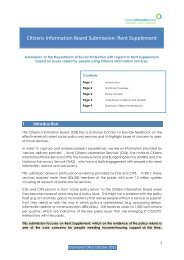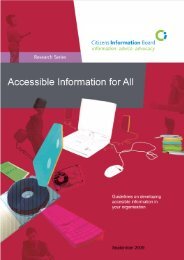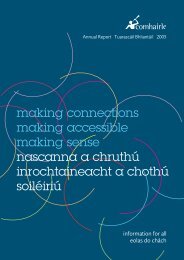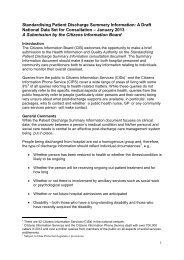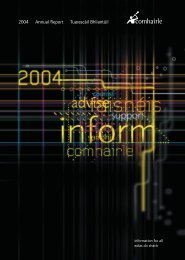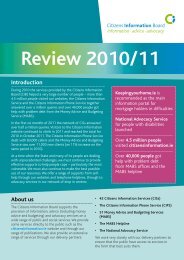5.3.4 <strong>Sign</strong> language interpretersSalaried <strong>and</strong>/or freelanceInterpreters may work as salaried employees <strong>of</strong> a service provider or <strong>of</strong> aninterpreting agency. A salaried post can provide security, training <strong>and</strong> peersupport <strong>and</strong> is <strong>of</strong>ten the first type <strong>of</strong> work done by an interpreter, for examplewhile undergoing training. Once qualified, <strong>and</strong> having gained enough experience<strong>and</strong> confidence, the interpreter may move into freelance work which can givemore freedom <strong>of</strong> choice <strong>and</strong> variety <strong>of</strong> assignments. In situations where there areplenty <strong>of</strong> interpreters available, salaried employment <strong>of</strong>fers the benefits <strong>of</strong> asteady income <strong>and</strong> a career path both for generic interpreters <strong>and</strong> those who arepart <strong>of</strong> a specialist team. This can be seen in Finl<strong>and</strong>, where previously a largenumber <strong>of</strong> interpreters worked as freelancers. However, the trend now is for more<strong>and</strong> more interpreters to become salaried. It is estimated that the ratio <strong>of</strong>employed to freelance workers is 3:1. A representative <strong>of</strong> the Finnish Association<strong>of</strong> <strong>Sign</strong> <strong>Language</strong> Interpreters has indicated that they expect the number <strong>of</strong>freelancers to “diminish a great deal in the future”.Generic <strong>and</strong>/or specialistMost interpreters work generically across a range <strong>of</strong> settings or domains. A study<strong>of</strong> interpreters in Britain found that the most common interpreting assignmentswere in employment, medical <strong>and</strong> social services. However, some interpreters goon to specialise in one particular area <strong>of</strong> work for example interpreting in court orin the theatre. These interpreters become known for their skills in a particular area,<strong>and</strong> <strong>of</strong>ten work directly with the funder <strong>and</strong>/or service provider, negotiating a ratefor their services. For example, in Scotl<strong>and</strong> there is an experienced BSL/EnglishInterpreter who is acknowledged by her peers as being a specialist in interpretingin legal settings. She has now set up an agency, <strong>and</strong> has contracts with most <strong>of</strong> thepolice forces in Scotl<strong>and</strong> <strong>and</strong> the court service. In the past, police <strong>of</strong>ficers neededto use the directory <strong>of</strong> the Scottish Association <strong>of</strong> <strong>Sign</strong> <strong>Language</strong> Interpreters(SASLI) to phone round all the registered interpreters. Now they have a 'one-stopshop'. The interpreter concerned has recently begun to employ anotherinterpreter, <strong>and</strong> subcontracts the rest <strong>of</strong> the work to other freelancers.Working remotelyAnother way in which sign language interpreters are now working is in a 'remote'capacity. As this is a relatively new way <strong>of</strong> working, it is unclear as to whetherinterpreters themselves want to work at the end <strong>of</strong> a telephone line <strong>and</strong> videocamera, without face-to-face contact with their users. However, working remotelycan provide a flexible way <strong>of</strong> working for interpreters who need to be home basedor might otherwise leave the pr<strong>of</strong>ession, for example, if travelling becomes toomuch for them. In view <strong>of</strong> the serious shortage <strong>of</strong> interpreters, it is likely thatservice providers <strong>and</strong> agencies will increasingly use <strong>and</strong> <strong>of</strong>fer remote interpretingservices. However, the views <strong>of</strong> interpreters <strong>and</strong> <strong>of</strong> Deaf users should be takeninto account when planning future services. The following section, (Section 5.4.1),addresses the area <strong>of</strong> remote interpreting in more detail.page 94 • <strong>Review</strong> <strong>of</strong> <strong>Sign</strong> <strong>Language</strong> <strong>Interpretation</strong> <strong><strong>Service</strong>s</strong> <strong>and</strong> <strong>Service</strong> Requirements in Irel<strong>and</strong>
SummaryThis review <strong>of</strong> how SLI services are delivered <strong>and</strong> organised in the countriesstudied, reveals a wide range <strong>of</strong> provision:• Different kinds <strong>of</strong> organisations providing SLI services• Use <strong>of</strong> salaried <strong>and</strong> freelance interpreters• Provision <strong>of</strong> generic <strong>and</strong> specialist services• The Deaf or service provider user responsible for booking the service• Better provision in urban than rural areasThe international research output highlights the importance <strong>of</strong> planning within anational strategy yet being responsive to local need. As part <strong>of</strong> the strategy, allthe countries have recognised the need to address the shortage <strong>of</strong> interpreters<strong>and</strong> to make the best use <strong>of</strong> what is a scarce human resource, through, forexample, remote interpreting.5.4 TECHNOLOGICAL DEVELOPMENTS INTERNATIONALLYThere are new developments in remote sign language interpreting being pilotedinternationally, particularly through the use <strong>of</strong>:• Video-relay/Videophones 20• WebcamsThe recent rapid growth in digital technologies <strong>and</strong> access to the internet, has thepotential to benefit Deaf people in many different ways. With the advent <strong>of</strong>relatively cheap, online access, mainstream equipment such as mobile phones, theinternet <strong>and</strong> personal computers, Deaf <strong>and</strong> hearing people are able tocommunicate at a distance in sign language <strong>and</strong> to communicate with people whodo not use sign language.5.4.1 Remote interpreting servicesA number <strong>of</strong> pilot projects have been established to assess the effectiveness <strong>of</strong>remote interpreting services using some <strong>of</strong> these technologies. The benefits <strong>of</strong>such systems, in the face <strong>of</strong> a continued shortage <strong>of</strong> interpreters, means thatthere is considerable investment being made in this area. Remote interpretingservices can provide access to Deaf people living in rural locations, or be used inan emergency situation when there is no time for an interpreter to travel to thelocation <strong>of</strong> the Deaf person. The use <strong>of</strong> video technology allows interpreters toundertake an increased number <strong>of</strong> assignments <strong>and</strong> to undertake moreassignments <strong>of</strong> short duration. In research conducted in Britain, it was reportedthat 62% <strong>of</strong> interpreters questioned in 2000 thought that greater use <strong>of</strong>technology would improve the availability <strong>of</strong> interpreting services (Brien D,Brown R, Collins J. 2002).20 The distinction between videophones <strong>and</strong> video relay is that a videophone is a piece <strong>of</strong> actual hardware (similar to a traditional telephone with ascreen), <strong>and</strong> video relay is a process whereby there is a relay in the communication process via a third party (i.e. a sign language interpreter).<strong>Review</strong> <strong>of</strong> <strong>Sign</strong> <strong>Language</strong> <strong>Interpretation</strong> <strong><strong>Service</strong>s</strong> <strong>and</strong> <strong>Service</strong> Requirements in Irel<strong>and</strong> • page 95



